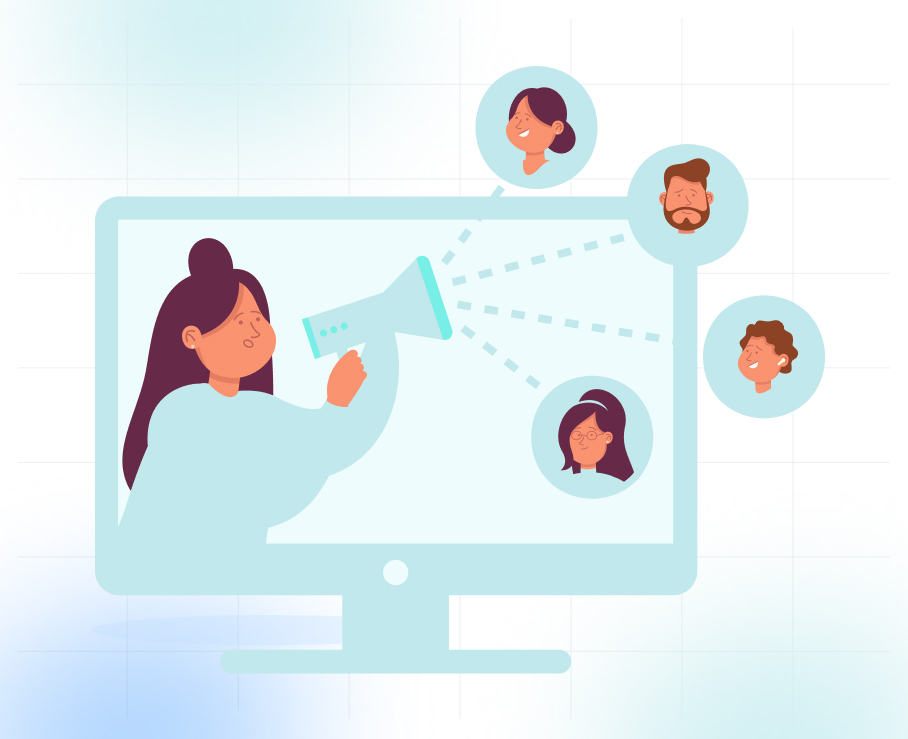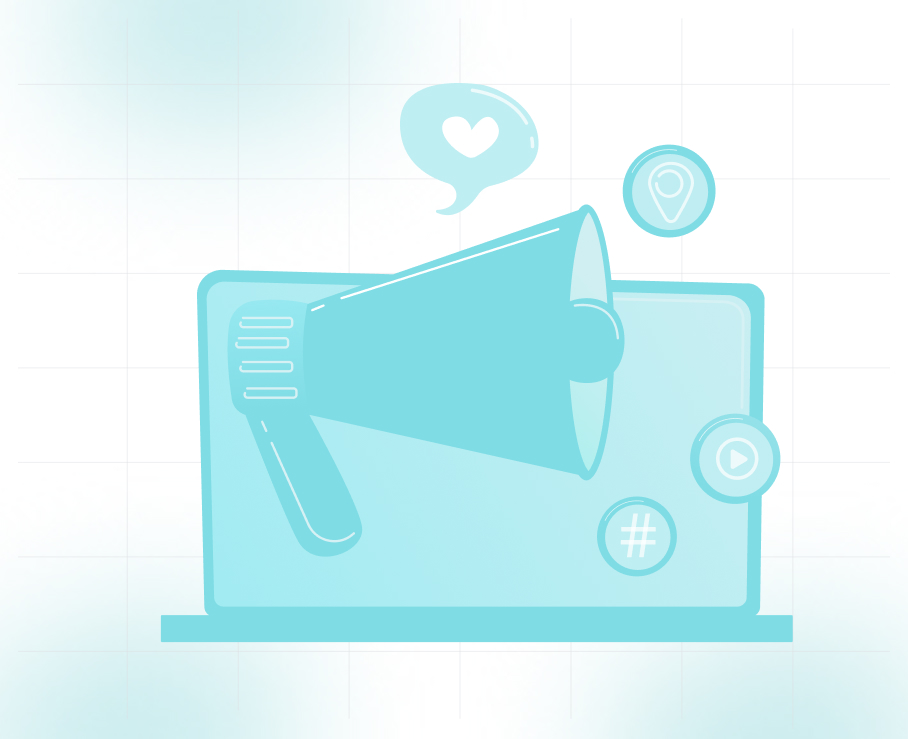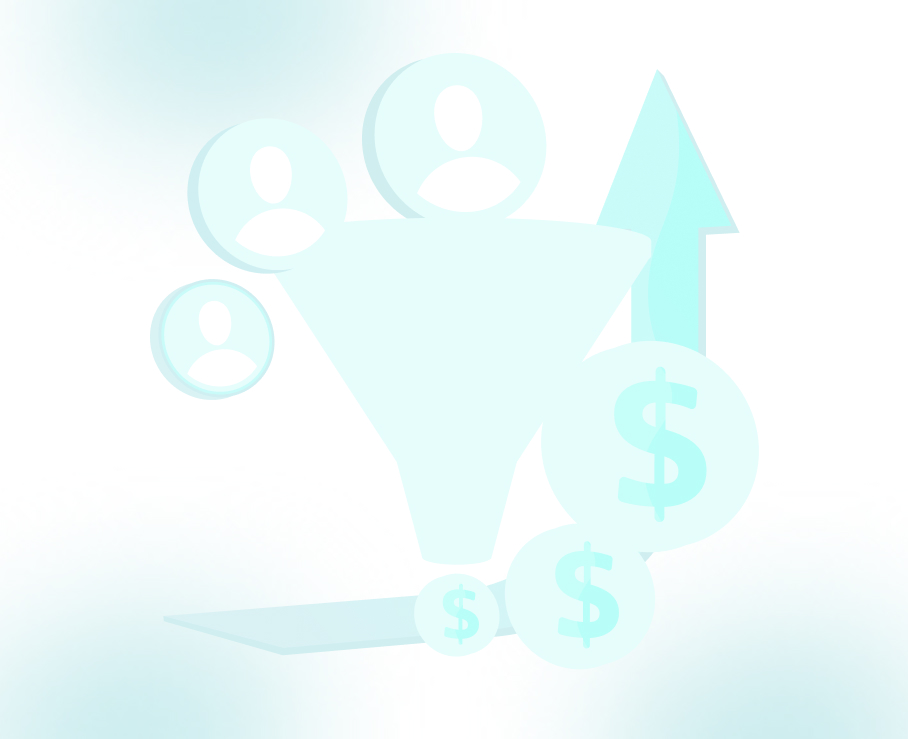
Understanding the Stages of a B2B Sales Funnel
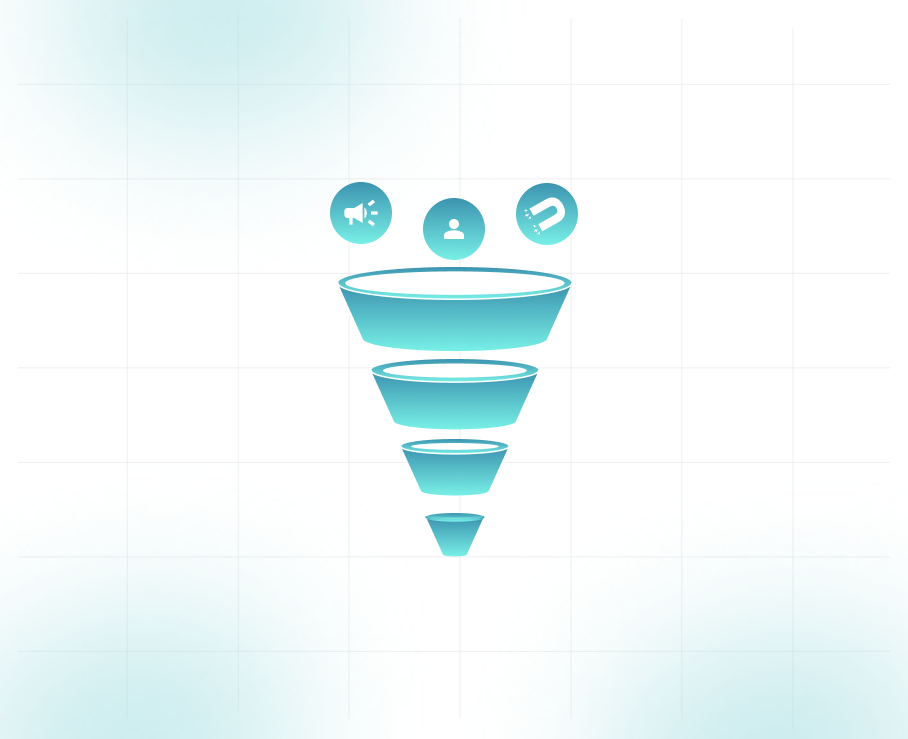
When you're trying to grow your B2B business, understanding how potential customers make their way to a purchase is important. That's where the B2B sales funnel comes in. It’s a powerful tool that helps you guide your prospects through their buying journey, ensuring that you don’t just capture their attention but also convert it into a sale.
In fact, 83% of B2B buyers spend most of their time researching, discussing decisions internally, and comparing options before even talking to a supplier. This makes the sales funnel a crucial map to ensure you’re engaging with the right content at the right time.
Let’s take a look at the stages of the B2B sales funnel and how understanding them can help you optimize the entire customer journey, from the moment they first hear about you to the time they make a purchase, and even beyond.
TL;DR
- A B2B sales funnel guides prospects from awareness to purchase, improving conversions and lead quality.
- The funnel has distinct stages: Awareness, Interest, Consideration, Decision, and Post-Funnel.
- Personalize content for each stage to nurture leads effectively and optimize the customer journey.
- Use data insights to refine and optimize the funnel, improving sales performance and ROI.
- Best practices, including content marketing and personalization, ensure your funnel performs at its best.
What Is a B2B Sales Funnel and Why Should You Care?
A B2B sales funnel is essentially a journey. It’s the structured process through which prospects move, from when they first become aware of your business to when they decide to purchase. The stages of this funnel allow your team to interact with prospects in a way that guides them through their decision-making process.
For businesses, having a clear, well-defined sales funnel is essential because it helps your team optimize how they engage with prospects. Each stage requires a different approach, whether it’s raising awareness, nurturing interest, or closing the deal. Understanding these stages helps you provide personalized content at just the right time, increasing your chances of converting prospects into loyal customers.
Key Differences: B2B vs. B2C Sales Funnels
While both B2B and B2C sales funnels aim for the same end goal, converting leads into customers, there are significant differences in how they operate.
B2B Sales Funnels are More Complex
Unlike B2C, where a single person often makes decisions, B2B sales funnels usually involve multiple decision-makers. This makes the sales cycle longer and more complex. In B2B, it’s not just about making a sale to a single individual; it’s about getting buy-in from different stakeholders within the organization, each of whom might have different concerns and requirements.
B2C Sales Funnels Tend to Be More Impulsive
In contrast, B2C funnels are generally more impulsive and straightforward. A consumer might make a purchase decision quickly, based on emotions or immediate needs. In B2B, decisions are rational and involve deeper research, so the sales process is longer, and the approach needs to be much more nurturing.
Implications for Content and Engagement
Because B2B buying decisions are more complex, B2B leads are more interested in educational content that speaks to their specific challenges. They need to see how your product solves a problem and delivers value. For B2C, the content is often focused on immediate benefits and emotional triggers that drive quick decisions.
Also Read: Top 8 Outbound Lead Generation Strategies for 2025
The Importance of a Well-Defined B2B Sales Funnel
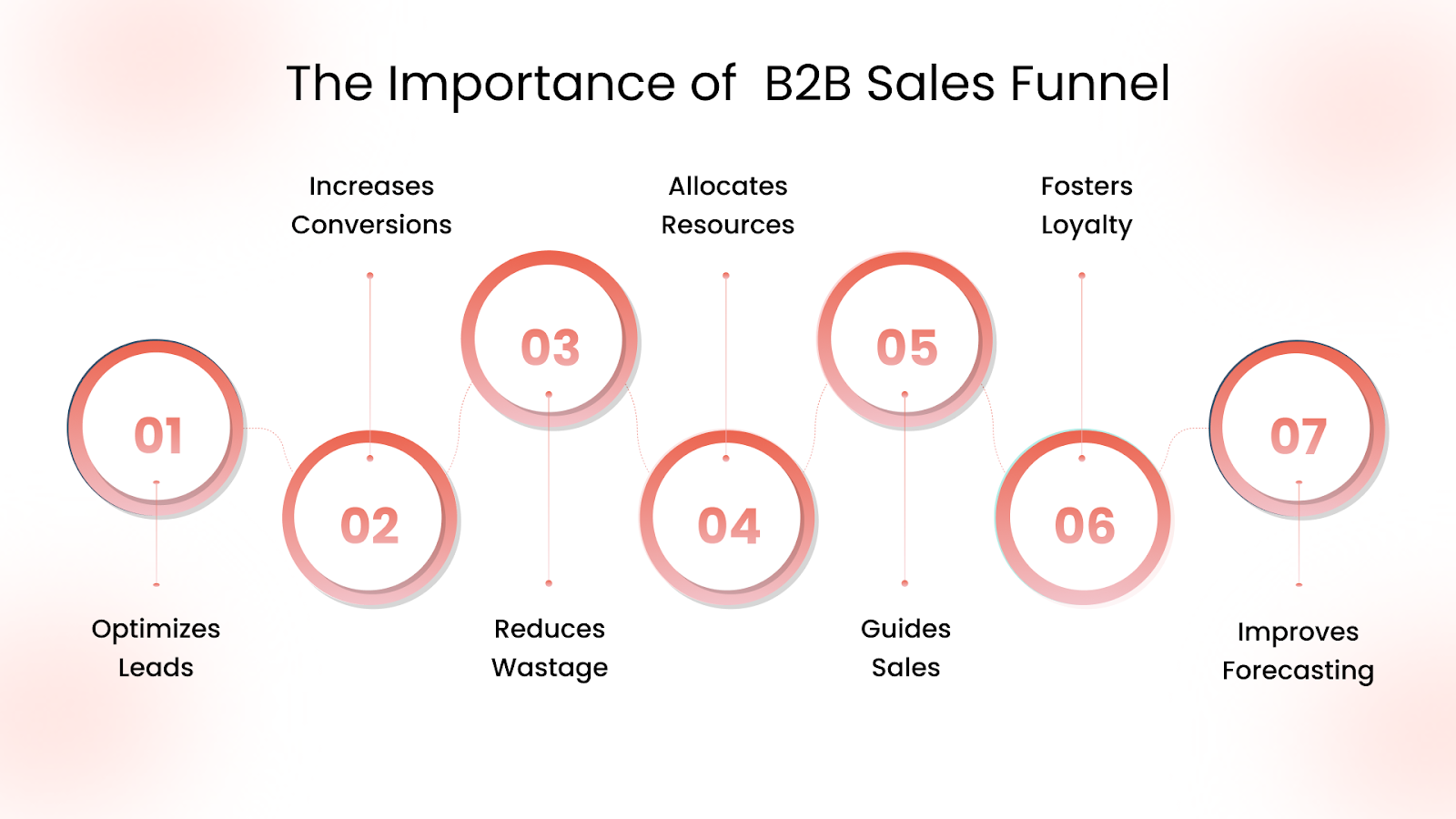
A well-defined B2B sales funnel is not just a tool but a strategic framework that helps guide prospects through their buying journey. Here’s why it’s essential for your business:
- Optimizes Lead Generation: A clear funnel ensures that you’re attracting and nurturing the right prospects at the right stage, improving the quality of leads entering the pipeline.
- Increases Conversions: By delivering the right content and messaging tailored to each stage of the funnel, you enhance engagement and increase the likelihood of turning leads into paying customers.
- Reduces Wasted Efforts: A structured funnel helps you filter out unqualified leads early, allowing your sales team to focus on prospects who are most likely to convert, saving time and resources.
- Improves Resource Allocation: With a clear funnel, you can allocate your marketing and sales efforts where they matter most, improving efficiency and reducing unnecessary expenditure.
- Guides Sales Team Engagement: Sales reps have a clear roadmap of what actions to take at each stage, ensuring that they’re always prepared with the right approach to move prospects forward.
- Builds Long-Term Relationships: Beyond the sale, the funnel helps you continue nurturing relationships with prospects and customers, encouraging repeat business and fostering loyalty.
- Enables Better Forecasting and Tracking: A well-structured funnel allows you to predict sales outcomes more accurately, giving you insights into revenue potential and the resources needed to meet targets.
A B2B sales funnel isn’t just a framework; it’s a strategic advantage that helps you guide your prospects seamlessly from initial awareness to purchase, all while optimizing your sales and marketing efforts for better results.
Also Read: Guide to Account-Based Marketing and Lead Generation to Boost Your B2B Success
Understanding the Four Main Segments of a B2B Sales Funnel
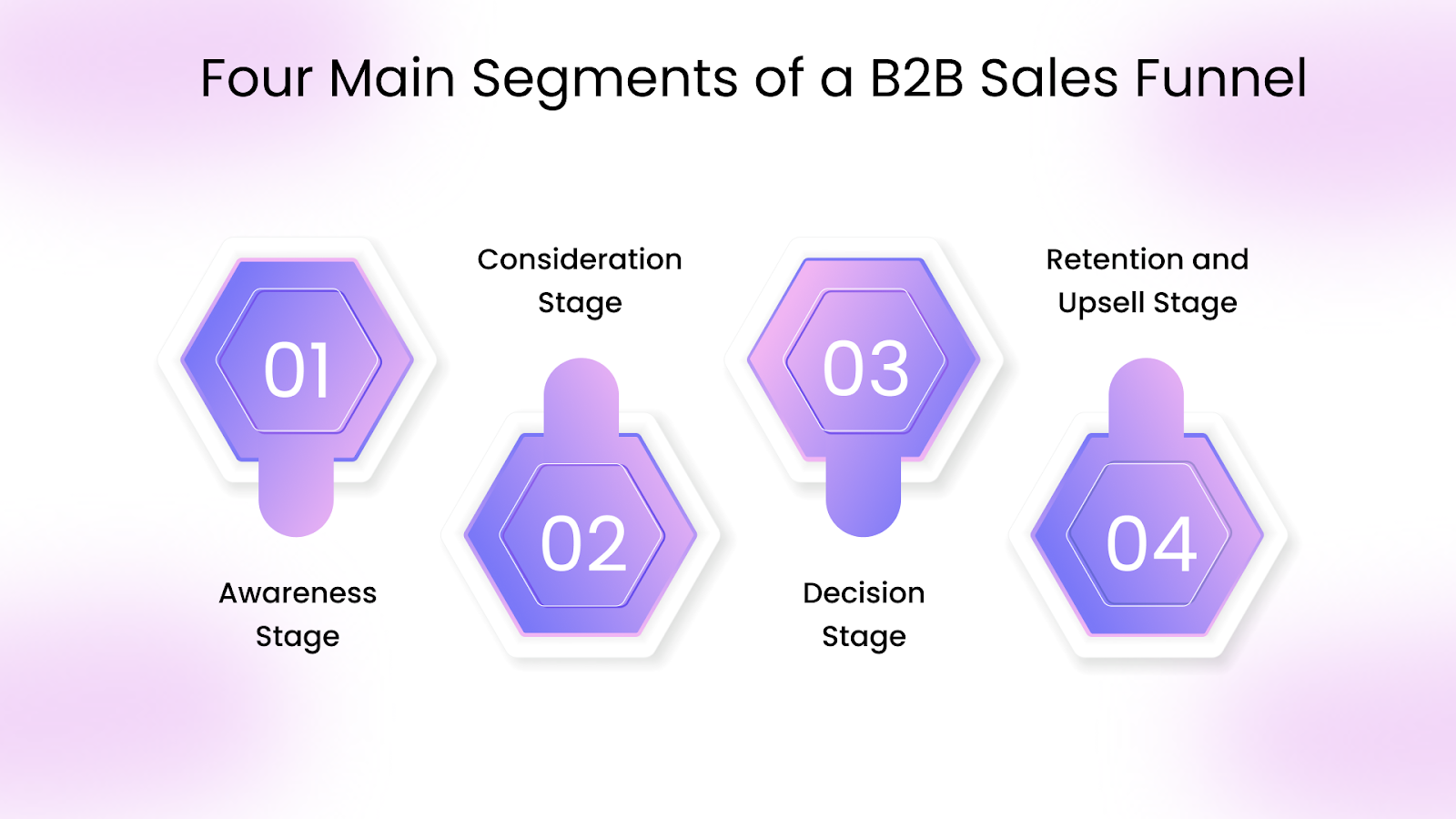
A B2B sales funnel is broken into distinct stages. Let’s explore these stages and understand their importance:
1. Top of the Funnel (TOFU) – Awareness Stage
At the top of the funnel, the goal is to introduce your brand to prospects and help them recognize a problem they may not have fully defined yet. People at this stage are not ready to buy; they’re just beginning to explore ideas, identify challenges, or stay informed about industry shifts.
This is where educational and thought-provoking content plays a key role. Think blogs that break down industry trends, short videos that explain common pain points, or light, narrative-driven case studies that highlight real challenges (without the sales pitch). These stories help potential buyers see themselves in similar situations and begin building trust with your brand.
Content Examples:
Blog posts, thought leadership articles, short educational videos, newsletters, and lightweight, insight-led case studies.
Key Activities:
Focus on brand visibility and problem awareness. Share helpful content that builds credibility, frames relevant pain points, and positions your business as a helpful guide, not a hard seller.
2. Middle of the Funnel (MOFU) – Interest & Consideration Stage
This is the stage where personalized, well-timed communication becomes critical. When a lead shows interest by signing up for a webinar or engaging with your content, it’s a good opportunity to follow up with thoughtful emails that address their specific pain points. Whether it's sharing relevant case studies or offering a resource that aligns with their role or challenge, these emails help deepen the relationship and build trust.
Key Activities: Send tailored emails that offer helpful insights, highlight relevant success stories, or invite prospects to explore your solutions further, based on the interests they’ve already shown.
3. Bottom of the Funnel (BOFU) – Decision Stage
At the bottom of the funnel, your prospects are no longer just exploring; they’re actively evaluating options and preparing to make a decision. This is your window to move from interest to action.
Now’s the time to lean into credibility and clarity. Focus on delivering content and conversations that reinforce your solution’s value, address any lingering concerns, and make it easy to take the next step.
Content Examples: Personalized walkthroughs, pricing breakdowns, customer testimonials, in-depth case studies, side-by-side comparisons.
Key Activities:
Offer clear next steps that make buying frictionless. This could be a personalized follow-up email with a scheduling link for an appointment, whether it’s to discuss specific needs, clarify pricing, or walk through how the solution would work for their use case. Keep the experience guided and low-friction, helping them move forward with confidence, not pressure.
The Lead Market (TLM) specializes in helping businesses scale their appointment setting with proven strategies. By focusing on lead generation, appointment scheduling, and account-based marketing, TLM ensures your outreach is not only consistent but meaningful. With our expertise, your sales team can build a stronger pipeline and close deals with greater momentum.
4. Post-Funnel – Retention and Upsell Stage
After the sale, the journey doesn’t end. Now, it’s time to nurture the customer relationship. This stage focuses on ensuring the customer is happy, finding new opportunities for upselling or cross-selling, and keeping the customer engaged to prevent churn.
Content Examples: Customer success programs, feedback surveys, loyalty programs, educational content.
Key Activities: Focus on customer retention and feedback gathering. Identify areas where additional products or services can be offered, and keep customers engaged with valuable content.
Also Read: How to Increase Sales with Effective Techniques
How to Build and Optimize Your B2B Sales Funnel
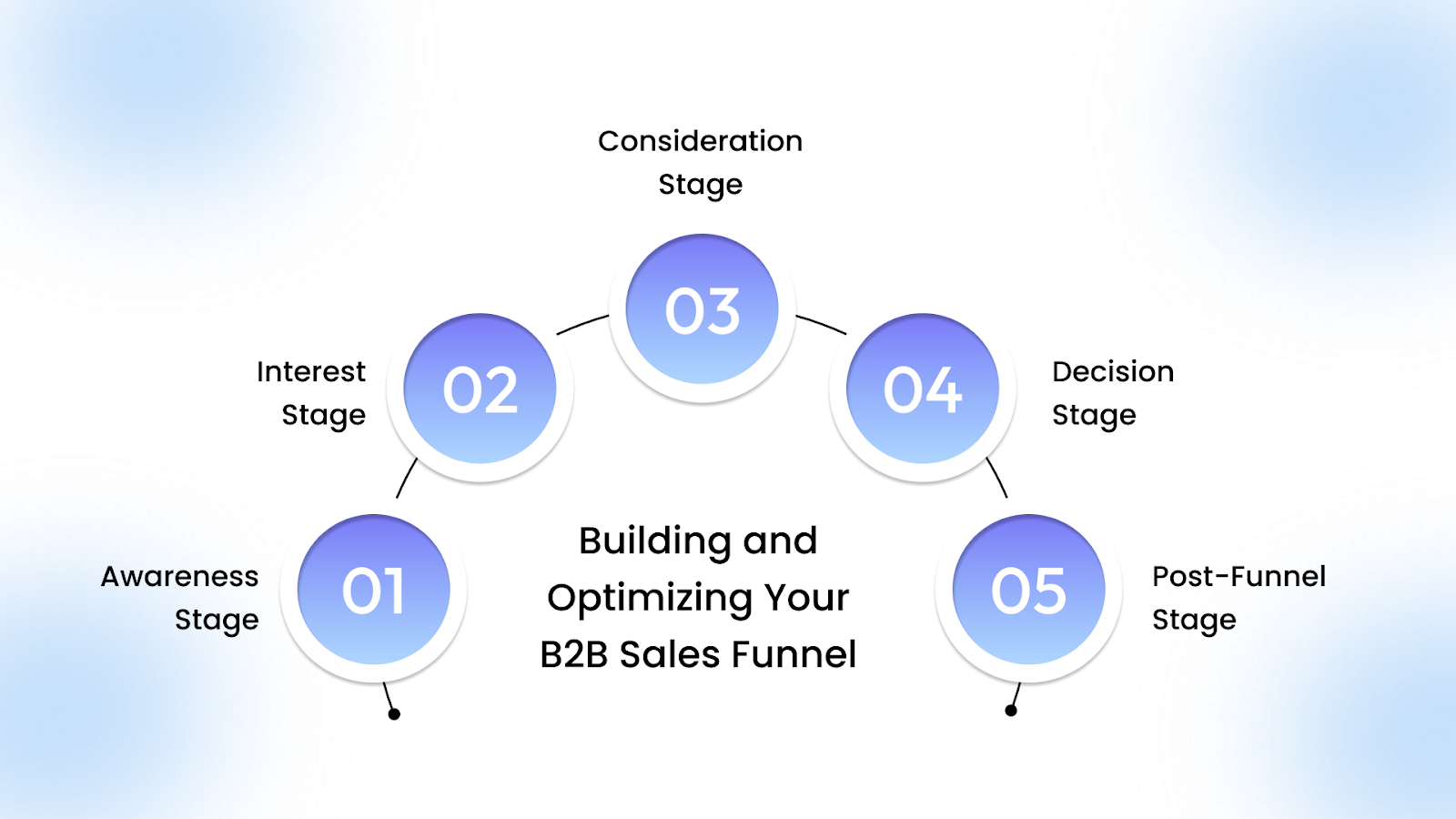
Building a B2B sales funnel isn’t about setting it and forgetting it; it's about continuously refining and optimizing it to guide prospects through their buying journey. Let’s walk through how you can build and optimize your sales funnel at each stage.
1. Awareness Stage
At the top of the funnel, your primary goal is to attract prospects and get their attention. Prospects may not know about your brand yet, so you need to make them aware of your products or services.
- Gathering Data: Leverage first-party data (like website behavior) and third-party intent data to understand what topics or solutions your prospects are actively searching for. This data helps you identify where they are in their journey and what problems they need solved.
- Content Strategies: Create content that addresses industry pain points, educates prospects about their challenges, and positions your brand as a solution. Blogs, social media posts, product videos, and podcasts are great ways to start educating prospects at this stage.
- Tools: To increase visibility, use SEO to rank higher in search results, employ content marketing to drive organic traffic, and launch lead generation campaigns to capture email addresses for further engagement.
2. Interest Stage
Once a prospect is aware of your brand, the goal is to nurture their interest and keep them engaged.
- Engagement: During this stage, prospects are actively exploring how your offering fits their needs. Start with targeted email campaigns to deliver relevant insights directly to their inbox. Follow up with content like webinars and eBooks to provide deeper context and demonstrate how your product or service addresses their challenges.
- Personalized Outreach: Send personalized emails, make introductory calls, or connect via social media to engage prospects directly. Showing genuine interest in their needs builds a stronger relationship and keeps them interested.
- Goal: The objective here is to move prospects further down the funnel by offering relevant educational content that adds value and aligns with their challenges.
Read: Why Email Marketing Is Today More Important Than Ever for B2B Growth
3. Consideration Stage
At this point, prospects are seriously considering solutions. Your job is to help them evaluate your solution and see how it fits their needs.
- Content Examples: Use a mix of product demos, testimonials, and well-crafted case studies to show, not just tell, how your solution solves real problems. Case studies, in particular, offer a narrative that prospects can relate to, helping them visualize how your product fits into their world without feeling like a sales pitch.
- Sales Reps: This is where your sales team should get more involved. Data-driven personalization is key. Understand the buyer’s pain points and provide tailored solutions. At this stage, prospects are evaluating how your product compares with others, so it’s essential to provide clear and compelling evidence.
4. Decision Stage
This is the point where prospects are ready to make a decision. Your job is to help them choose your product by addressing any last-minute concerns.
- Address Objections: Be prepared to handle objections that might come up and provide additional information that reassures them of your product's value.
- Content Examples: Share comparison data, customized offers, and support content that reassures prospects about their decision. Help them visualize the return on investment (ROI) and the impact on key metrics like monthly recurring revenue (MRR), while clearly explaining the tangible benefits your product provides.
- Sales Team: This is where your sales reps need to shine, guiding the prospect through any remaining doubts. Focus on building trust and demonstrating that you are the best option to meet their business goals.
5. Post-Funnel Stage
Once the deal is closed, it’s time to focus on customer success and retention. This is where loyal customers are turned into repeat buyers.
- Onboarding: Ensure that your new customers have a smooth onboarding experience. Properly onboarded customers are more likely to see the value of your solution and become long-term users.
- Retention Strategies: Keep customers engaged with loyalty programs, customer success initiatives, and personalized outreach. Continuously provide value to your customers and look for opportunities to upsell or cross-sell based on their evolving needs.
- Turn Customers into Advocates: A satisfied customer can become a great source of referrals. Make sure to keep them happy and ask for feedback or testimonials to use in future stages of the funnel.
Also Read: Ultimate Lead Qualification Checklist: Convert More Sales in 2025
Best Practices for Optimizing Your B2B Sales Funnel
- Map content to buying intent, not just funnel stage: Match content to real behavior, like repeat visits, pricing page views, or webinar signups, rather than assuming interest based on stage alone.
- Use data signals to prioritize leads: Implement lead scoring based on engagement depth (e.g., reading a case study > opening a newsletter) so your team focuses on high-intent accounts.
- Streamline the handoff between marketing and sales: Create a shared view of lead activity so sales reps can see which assets a prospect engaged with and pick up the conversation without repeating earlier points.
- Keep CTAs low-friction: Instead of just “Book a demo,” try “Pick a time that works for you” with an embedded calendar link. Every unnecessary step increases drop-off.
- Make case studies relatable and role-specific: Generic success stories won’t cut it. Customize or segment case studies by industry, company size, or function for stronger resonance.
- Review funnel drop-offs monthly: Audit conversion rates at each funnel stage. A sharp drop from interest to consideration? That’s a signal that your content or outreach isn’t convincing enough.
- Never stop nurturing after the sale: Set up automated check-ins, feedback loops, and product tips to retain attention and open upsell opportunities without sounding salesy.
- Build segmented email nurtures based on behavior, not demographics: Instead of generic drip sequences, trigger emails based on what prospects do, like downloading a guide, revisiting the pricing page, or forwarding a case study. These micro-signals reveal interest far better than job title or industry, and turn cold leads into warm conversations.
Optimizing your B2B sales funnel is about guiding—not pushing—your prospects. When every touchpoint is intentional and informed by data, you don’t just get more leads; you get better ones.
With 9+ years of experience in B2B lead generation, appointment setting, and account-based marketing, TLM helps businesses like yours turn engagement into pipeline, and pipeline into growth. Whether you're launching a new campaign or scaling an existing one, we’ll craft strategies that move prospects with purpose.
Ready to turn prospects into sales-qualified leads? Let’s talk about how we can make that happen.
Also Read: 8 Proven Best Practices To Increase B2B Appointment Setting Success
Metrics to Track and Optimize Your B2B Sales Funnel
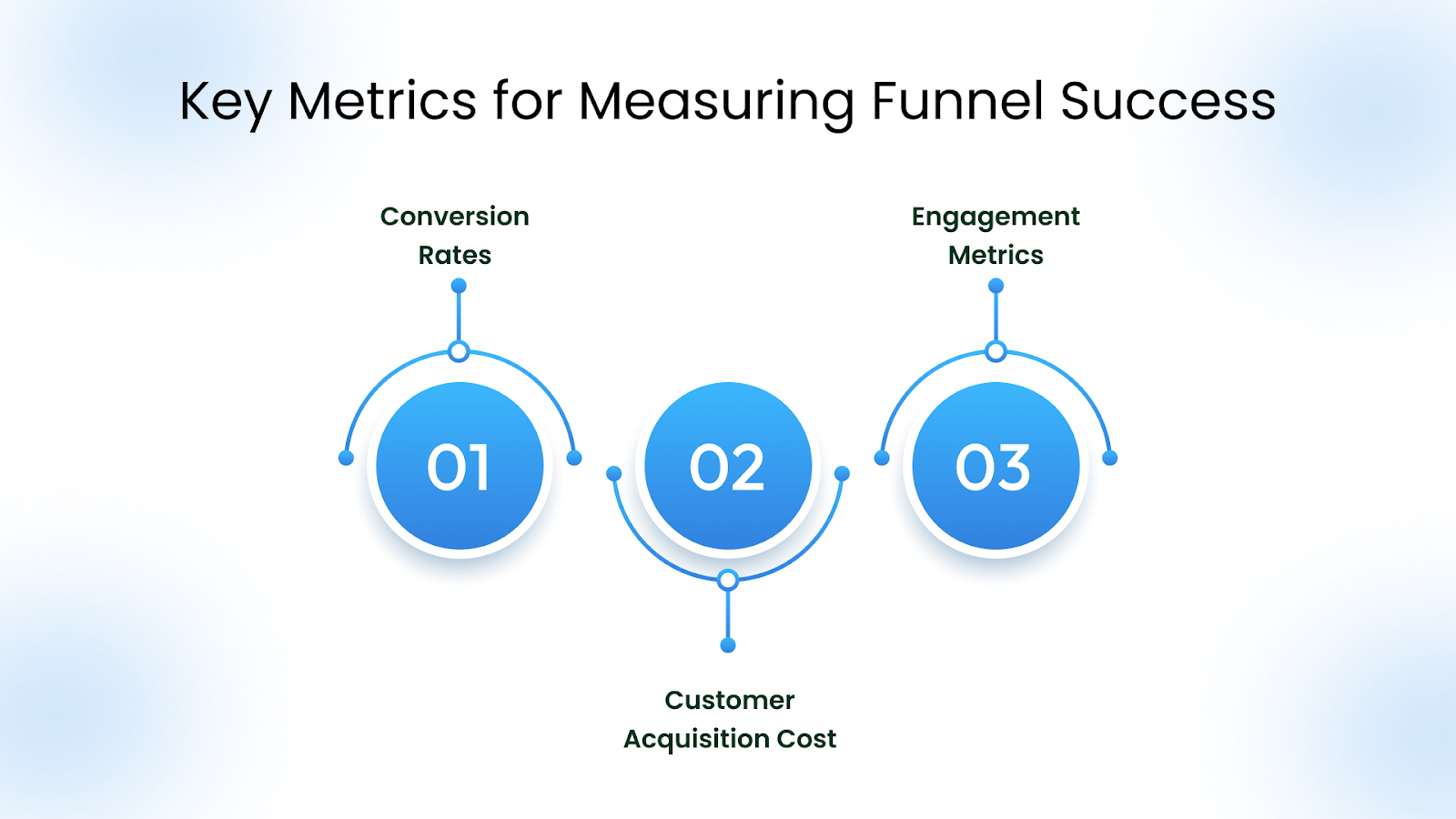
To ensure your B2B sales funnel is performing optimally, it’s essential to track key metrics at every stage. These insights will help you identify bottlenecks, improve engagement, and ultimately increase conversions.
Key Metrics for Measuring Funnel Success:
- Conversion Rates: Track how prospects move from one stage to the next. A drop in conversion rates indicates a need for adjustments in your content or approach at that specific stage.
- Customer Acquisition Cost (CAC): Measures the cost of acquiring a customer at each stage. This helps you determine whether your marketing and sales efforts are cost-effective or need recalibration.
- Engagement Metrics: Monitor email open rates, content downloads, webinar participation, and social media interactions. High engagement at each stage suggests that your content is resonating with leads.
How to Use Data to Optimize the Funnel:
- Regularly Review Funnel Performance: Analyze conversion rates, engagement levels, and CAC to identify where improvements can be made. Regular reviews help prevent leads from falling through the cracks.
- A/B Testing: Continuously test different strategies, such as content formats, messaging, or calls to action. Small adjustments can lead to big improvements in funnel performance.
- Customer Feedback: Collect feedback through surveys or direct conversations to understand pain points and optimize future interactions. Prospects’ concerns will often reveal areas for improvement in your funnel.
- Refine Your Strategy: Use the data to make adjustments at each stage, whether it's tweaking your content, personalizing communication, or rethinking your lead qualification process.
Read: Understanding the Importance of Data Freshness in Generating Quality Leads
How TLM Helped a US Software Company Transform Its Lead Generation and Grow Sales
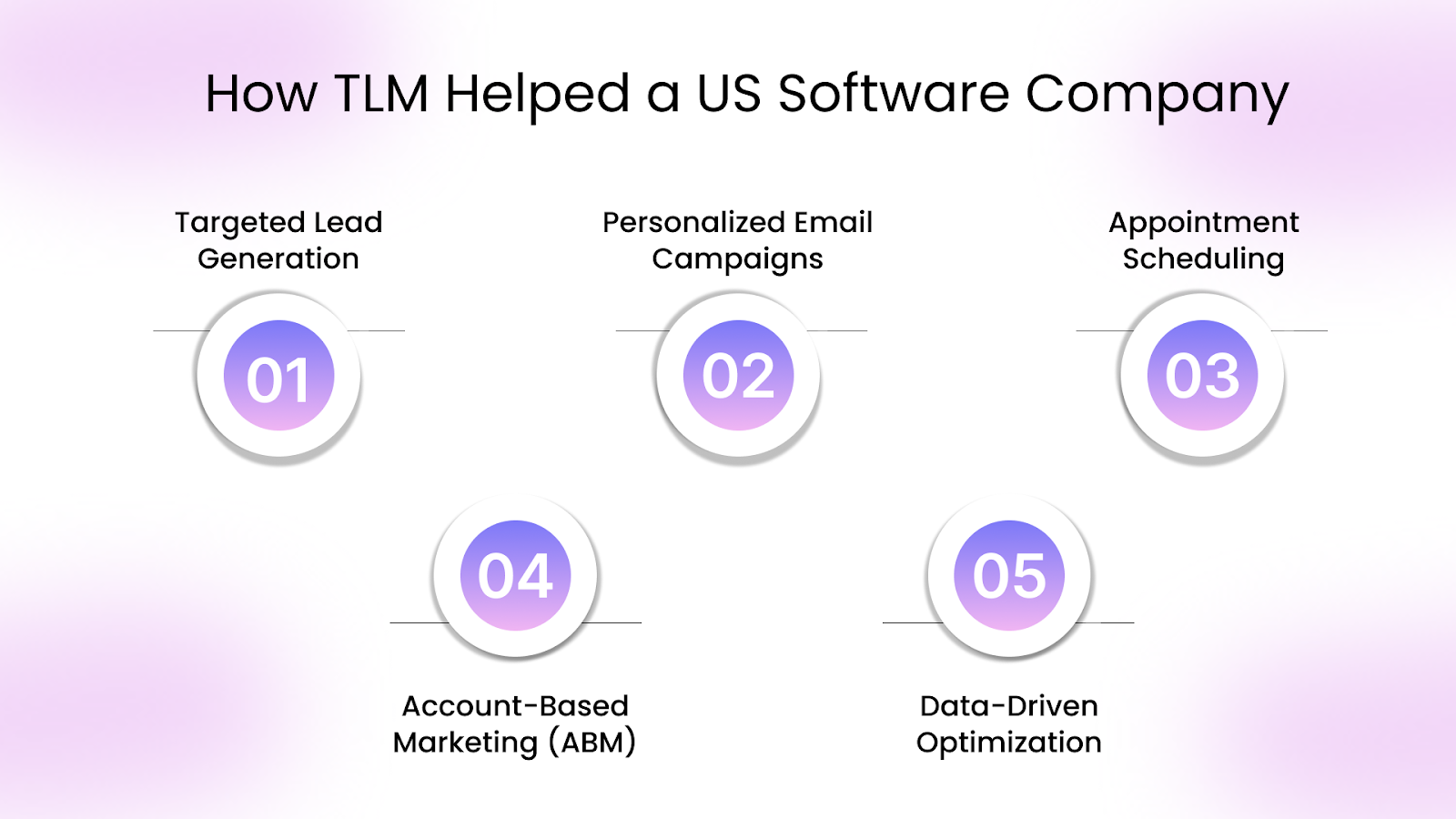
A software development company based in Dallas, Texas, needed to expand its reach beyond local clients and attract quality leads. Despite previous attempts with other agencies, they were frustrated with poor lead quality and lack of communication.
TLM stepped in with a tailored approach, utilizing our deep knowledge of the Dallas area. We crafted a comprehensive B2B campaign, engaging multiple industries including automotive, food, retail, and finance.
Results started slowly, but within six months, the client saw consistent lead flow and greater control over their sales budget. Today, we’re scheduling 3-4 appointments per month, with real closures. The client now has a reliable, effective lead generation system driving growth.
This success was driven by TLM's expertise in B2B email marketing and lead generation. Our services are designed to help businesses like this software company achieve their goals by:
- Targeted Lead Generation: We focus on building precise, segmented email lists to ensure your messages reach the most relevant prospects.
- Personalized Email Campaigns: Our team creates tailored, audience-specific messages to boost engagement and improve response rates.
- Appointment Scheduling: We streamline the process of booking meetings with qualified leads, ensuring your sales team spends less time chasing leads and more time closing deals.
- Account-Based Marketing (ABM): For high-value accounts, we deploy customized email strategies that speak directly to decision-makers, accelerating the sales cycle.
- Data-Driven Optimization: Using advanced analytics and TLM’s proprietary tools and real-time dashboard, we continuously monitor campaign performance. This enables us to adjust targeting, refine messaging sequences, and align outreach timing based on real behavioral signals, ensuring your strategy evolves with every insight.
Remember, your sales funnel is not a one-time setup; it’s an ongoing process that needs to be optimized based on data, insights, and market changes. A customer-centric, data-driven approach will ensure you remain adaptable and successful in guiding your prospects through their journey, turning them into loyal customers. With TLM’s proven methodology, we can turn your lead generation efforts into a well-oiled system that drives consistent sales pipeline growth.
FAQs
1. What are the 7 steps of the B2B selling process?
The 7 steps of the B2B sales process include preparation, prospecting, need assessment, pitch, objection handling, closing, and follow-ups for repeat business and referrals.
2. What is the B2B life cycle?
The B2B lifecycle refers to the journey a customer goes through, from lead nurturing to conversion and retention. It involves multiple touchpoints before finalizing a sale.
What is the B2B sales process flowchart?
The B2B sales process flowchart maps out decision-making steps with Yes/No scenarios, guiding sales teams through each stage of engaging and converting prospective customers.
What are the 7 P's of B2B?
The 7 Ps of B2B marketing include product, price, place, promotion, people, process, and physical evidence, which help businesses align marketing strategies with customer expectations.


